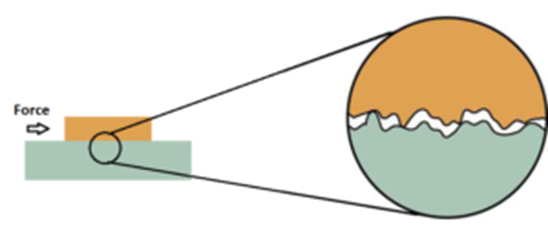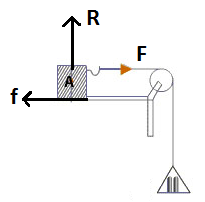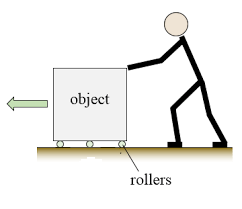Science > Physics > Friction > Concept of Friction
Friction or force of friction is a force which comes into existence when two bodies in contact have relative motion or tending to have relative with respect to each other and oppose the motion.
Characteristics of Friction:
- Force of friction is always opposites to the force causing the relative motion between the surface.
- Force of friction always acts at the points of contacts of the two surface.
- As the force causing motion increases the frictional force increases up to certain maximum value and that maximum value of the force of friction is called limiting friction.
- The frictional force is independent of the area of contacts.
- The frictional force is independent as nature of surface in contact.
- The frictional force depends on the nature of materials of surface in contact.
- Frictional force depends on lubrication.
Notes:
- Even there is no actual relative motion between the two bodies or surfaces the force of friction comes into play whenever the bodies are kept in contact
- Frictional force always opposes the motion.
- Friction is partially due to unevenness of the surfaces in contact and partially due to molecular attraction between the molecules of the two surfaces in contact.
- If the contact surfaces are made very smooth, it still does not minimise the frictional forces, because in this case the intermolecular forces of attraction increase due to better contact.
- Force of friction is greater in case of two surfaces made of the same material as in this case the forces of attraction between the molecules of the surfaces are cohesive forces which are greater than the adhesive forces.
- Frictional force when the body is at rest or on the verge of motion is called static friction whereas when the body is in motion the frictional force is called the kinetic friction.
Friction a Self-Adjusting Force:
Friction is a force which comes into existence when two bodies in contact have relative motion or tending to have relative with respect to each other and oppose the motion.
When the applied force is zero, the force of friction also equal to zero. If the applied force is slowly increased, the force of friction, in the same proportion up to a particular limit. This force is called the limiting force of friction. Within this limit, the force of friction is exactly equal and opposite to the applied force.
If the direction of the applied force is changed the direction of the force of friction also changes in such a way that it is opposite to the direction of the applied force.
Thus the magnitude and direction of frictional force depend upon the magnitude and direction of the applied force. Hence we can say that the force friction is called self-adjusting force. Hence the force of friction does not have an independent existence. It comes into play only when the applied force produces or tends to product relative motion between two bodies in contact.
Origin of Friction:

Earlier it was assumed that the force of friction between two surfaces in contact comes into existence due to roughness of the surfaces.
When the two surface seems to be in contact actually there is no surface to surface contact. It is due to the fact that irrespective of smoothness of the surface, it contains hills & dales (Projections and depressions). This unevenness of the surface can be observed under a microscope. These surface irregularities have the effect of interlocking the surfaces thereby opposing the relative motion of the two surfaces with respect to each other. This opposition contributes to frictional force in a small extent.
A major contribution to the frictional force can be explained on the basis of molecular theory. Due to hills and dales, there is no surface to surface contact but there is point contact. Due to point contact there exist a very high pressure at contact points. Due to high pressure, the molecules of the two surfaces at the point of contact get cold-welded and thus the bonding exists between the two surfaces in contact.
When the two surfaces in contact tend to have relative motion with respect to each other these bonds or cold-welded and joints do not allow them to so. To create relative motion additional force is required to break these cold welded joints. This additional force explains the origin of friction and is called a force of friction.
Types of Friction:
There are three types of friction: a) Static friction b) Kinetic friction c) Rolling friction
Static Friction:
The frictional force which exists between the two surfaces which are at rest or which are on the verge of relative motion with respect to each other is called the static friction.
Kinetic Friction (Dynamic Friction):
The frictional force which exists between two surfaces in contact having relative motion with respect to each other is called kinetic or dynamic friction.
Rolling Friction:
The frictional force which exists between two surfaces in contact, when one body rolls over the other.
Laws of Static Friction:
- Limiting static friction between any pair of dry unlubricated surfaces is independent of the apparent area in contact.
- Limiting static friction between any pair of unlubricated surfaces depends on nature and material of the surfaces in contact.
- Limiting static friction between any pair of dry unlubricated surfaces is directly proportional to the normal reaction.
If FS is static friction and R (N) is a normal reaction.
Then, FS ∝ R
∴ FS = μS R
Where, μS = coefficient of static friction.
∴ μS = FS /R
The coefficient of static friction is defined as the ratio of the limiting static friction to the normal reaction.
Laws of Kinetic Friction:
- Kinetic friction between any pair of a dry unlubricated surface is independent of the apparent area in contact.
- Kinetic friction between any pair of dry unlubricated surfaces depends on the nature of the material in contact.
- Kinetic friction between any pair of the dry unlubricated surface is directly proportional to the normal reaction.
If Fk is kinetic friction and R (N) is a normal reaction.
Then, Fk ∝ R
∴ Fk = μk R
Where, μk = coefficient of static friction.
∴ μS = Fk /R
The coefficient of Kinetic friction is defined as the ratio of the kinetic friction to the normal reaction.
Experiment to verify the law that the limiting force of friction is directly proportional to the normal reaction the two surfaces in contact.

A wooden horizontal plane with a pulley attached to one end is taken and kept on a table. A wooden block is placed on the horizontal surface. A string is tied to the weight and is passed over the pulley and a pan is attached to its free end.
Weight is added to the pan until the block began to slide. The sum of the weight of the pan and the weight put in it is equal to the limiting force of friction. The normal reaction is equal to the weight of the block.
Some weight is put on the block and the procedure is repeated as given above. In this case, the normal reaction is equal to the weight of the block plus the weight put on it. Let us call it R1, Let the corresponding frictional force be f1. The experiment is repeated with different weights on the block. If f, f1, f2, f3, ….. are the frictional forces and R, R1, R2, R3, ….. are the corresponding normal reactions then it is found that
Thus, in general f/R = Constant
This relation proves that the limiting force of friction is directly proportional to the normal reaction. Thus the law is verified
Next Topic: Applications of Friction

One reply on “Friction”
Thank you for the concise notes